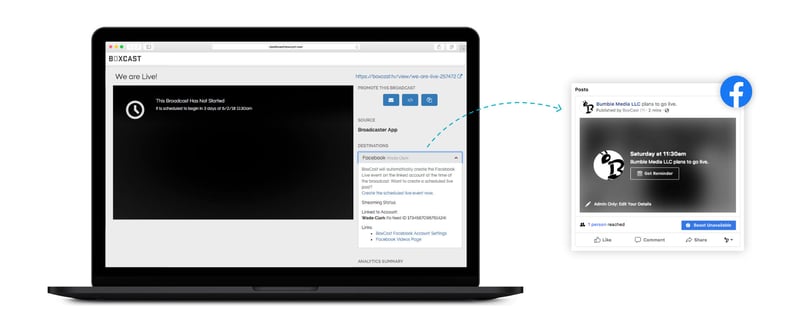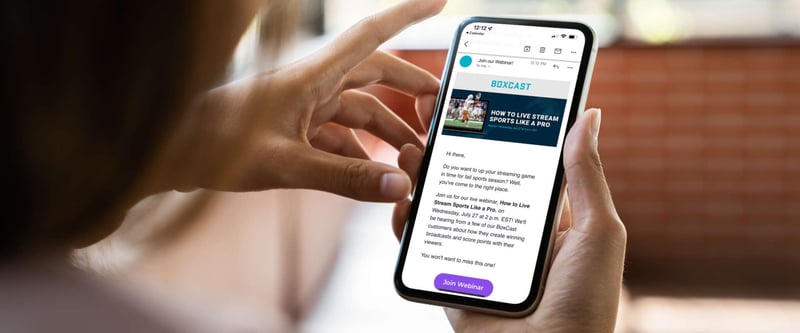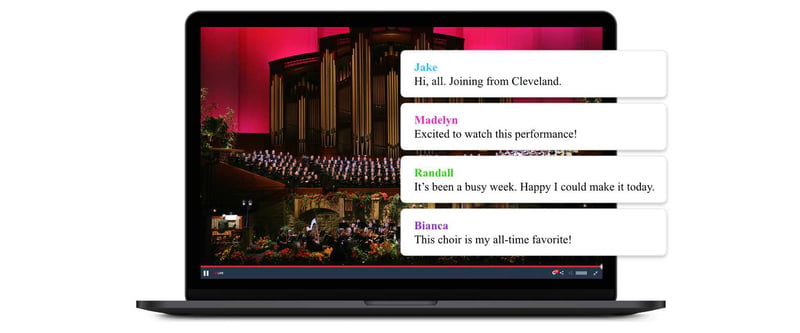VIDEO
Products
Streaming
Deliver flawless live video to any audience, anywhere
OTT Apps
Launch and monetize your own branded TV & mobile apps
Spark Encoder
Tap into hardware encoding that's compact and powerful
Broadcaster App
Go live straight from your phone or tablet with studio-quality control
Features
BoxCast Flow
Ensures smooth playback even on shaky networks
Sharing
Instantly clip, share, and amplify your broadcasts
Producer
Create professional streams right from your browser
Third-Party Encoders
Use the gear you love with our support of RTMP and SRT
AUDIO
RemoteMix
Mix live audio remotely from anywhere in the world
Compatible Mixers
Connect your favorite digital mixer to RemoteMix
INDUSTRIES
House of Worship
Reach and engage your congregation wherever they worship
Sports
Stream games with professional quality for fans everywhere
Local Government
Bring transparency and connection to your community broadcasts
Business
Power your corporate events, webinars, and live streams
LEARN
Blog
Insights, trends, and tips for the audio/video community
Tech Tips
Quick how-tos and deep dives on the latest streaming technology
Guides
Essential tips and expert strategies to expand your reach
Newsletter
Stay up to date with product news, best practices, and more
Podcast
Hear stories and strategies from our customers and experts
DISCOVER
Customer Stories
Explore real-world success stories to inspire your organization
Events
Join us at an upcoming conference and meet with our team
Webinars
Get all the details and register for our next live webinar
About Us
Discover our company's mission, values, and team story
Broadcasting, Live Streaming by Industry, Church + House of Worship, Hybrid Events, How To Live Stream

BoxCast Team • September 22, 2022
Once autumn has settled in and the year draws to a close, we begin to look forward to upcoming holidays and major streaming events. But most importantly, we want to help ensure you have everything you need to reach your audience and achieve your live streaming goals.
This post covers the importance of live streaming, engagement, and promoting your streams, along with some examples that show how to do it well.
This simple formula can help even a one-person crew accomplish their streaming goals during the holiday season. Let’s break down each part of the equation.
Live streams are essential. You can’t have a successful holiday season without a stream. Why? Because the majority of US states experience colder temperatures, snow, bad weather, and poor traffic conditions. Also, October through December is the busiest time of the year. People are traveling, prepping for holidays, and squeezing in those last few days off, which means they aren’t always home or available to attend events in person. So they need the option to watch things on the road or from afar.
For obvious reasons, viewership is also crucial. A live stream can’t be deemed successful if no one watches it. So promoting and preparing your viewers for upcoming broadcasts is a must. Let’s talk about promoting your streams.
Here are a few options, ranked in order of easiest/most popular to most difficult.
Promoting your streams on social media is a great way to expand your audience beyond those who are part of your organization. You can reach new viewers who search for related events or categories and stumble upon your stream.
You can also have dedicated followers of your channels who go there to know when and where the upcoming streams will be. Another way to get the word out is to create a Facebook group specifically for your organization or invite followers to a Facebook event with all the details. Both allow for a more niche way of interacting with people who plan to attend the event in person or virtually.
If you're using a broadcasting platform like BoxCast, you can automatically let your social media followers know you plan to go live. If you've scheduled a live stream in advance, your social media platform of choice will create an announcement post on your profile. This will notify your followers when you'll be live streaming on that particular platform.

One way to let viewers know when upcoming events are is to email them before they happen. A good marketing rule here is the rule of threes. This rule has a few different approaches, but we’re explicitly talking about emailing your list three times for this marketing channel.

Your email cadence can look like this:
Each email has a purpose. Email one is for awareness and planning. You should have all the details ready and available, along with a sign-up call-to-action link (if required). Components should include the event stream's date, time, and URL. Email two is a gentle nudge reminding people not to forget your event is coming up. The last email is for accessibility, and puts the link to your live stream at the top of their inbox for easy access.
Engagement is the last piece of the equation, but certainly not the least valued. Engagement can be the act of interacting with your remote audience live via chat, or the after-live exchange on social media or through conversation. We’ll break down both.
Engaging viewers during the live stream is an easy way to ensure viewers on the other side of the screen feel included. Most streaming platforms have a chat feature built into their dashboards or platforms. Here at BoxCast, we use our Viewer Chat feature. It allows the host to start and moderate conversations, ask questions, provide links or resources, and let participants react.

Engagement after the broadcast has ended is equally important. If you let viewers watch via social media, you’ll want to be sure you’re ready to respond to questions and comments. While the chat won’t be live after the recording, some folks may still have things to say through private messages, email, or comments.
Now that you know the key factors to success, you’re ready to get out there and make any holiday or end-of-year stream the best it can be!
Remember: The execution of your live stream is just as important as the actual event — so be sure to plan for your hybrid event from all aspects, not just the in-person part. Want more info on hybrid events? Watch this episode of the BoxCast Podcast:
Listen to this podcast episode instead of watching:
We've got a bevy of resources to help you put on the best year-end and holiday live stream. Check out these articles to learn more about streaming hybrid and virtual events:
© 2025 BoxCast. All Rights Reserved. | +1-888-392-2278